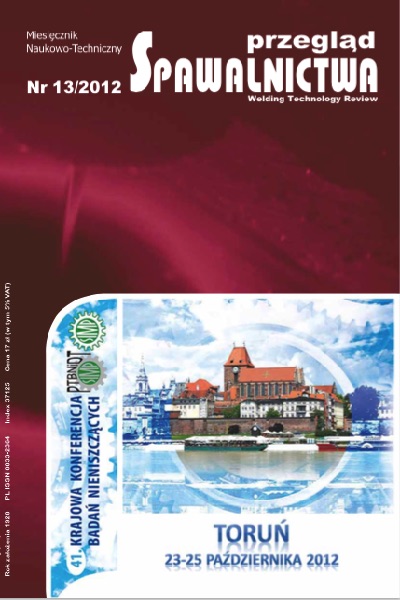Stan rozwoju metody diagnozowania materiałów z wykorzystaniem efektu emisji magnetoakustycznej
Main Article Content
Abstract
Zjawisko emisji magnetoakustycznej polega na generacji dźwięku na skutek ruchu granic domenowych (nie 180o) w materiałach o niezerowej magnetostrykcji. Zaprezentowano aktualny stan wiedzy odnośnie do możliwości zastosowania efektu emisji magnetoakustycznej (EmA) do diagnozowania, w sposób nieniszczący, stanu materiałów konstrukcyjnych. Omówiono problemy związane z metodyką pomiaru, ze szczególnym uwzględnieniem pomiarów w warunkach przemysłowych oraz przedstawiono metody umożliwiające uzyskanie użytecznych sygnałów w tych warunkach. Przedstawiono szerokie spektrum możliwych zastosowań pomiarów natężenia sygnału EMA: badanie stopnia degradacji materiałów eksploatowanych w energetyce, diagnozowanie stopnia deformacji plastycznej, ocenę jakości obróbki cieplnej oraz możliwość analizy zmian struktury domenowej w stalach elektrotechnicznych wywołanych naprężeniami.
Recent development in material state evaluation with the use of magnetoacoustic emission effect measurements
Abstract
magnetoacoustic emission signal is generated by the movement of non 180o domain walls in materials with non-zero magnetostriction. The paper presents the up to date state of knowledge concerning the possibility of application of the magnetoacoustic emission (MAE) for diagnosing, in a nondestructive way, the state of engineering materials. The paper discusses the possible complications connected with the measurements with special attention paid to measurements in the industrial environment. It also presents the methods enabling reliable measurements in such conditions. The wide range of possible application of the MAE signal measurements is discussed: monitoring of the degradation processes in the materials exploited in power plants, determination of the plastic deformation level, heat treatment quality assessment and in addition to that the possibility to analyze the changes in the magnetic domain structure in electrical steels resulting from elastic stresses application.
Downloads
Article Details
Creative Commons CC BY 4.0 https://creativecommons.org/licenses/by/4.0/
Welding Technology Review (WTR) articles are published open access under a CC BY licence (Creative Commons Attribution 4.0 International licence). The CC BY licence is the most open licence available and considered the industry 'gold standard' for open access; it is also preferred by many funders. This licence allows readers to copy and redistribute the material in any medium or format, and to alter, transform, or build upon the material, including for commercial use, providing the original author is credited.
References
Lord A.E., Jr. Acoustic emission. W. Physical Acoustics. Ed.: mason W.P., Thurston R.n., new York, Academic, 1975, s. 290.
Shibata m., Ono K.: magnetomechanical acoustic emission a new method for non-destructive stress measurement. NDT International; 1981, s. 227-234.
Kwan m.m., Ono K., Shibata m.: magnetomechanical Acoustic Emission of Ferromagnetic materials at Low magnetization Levels (Type I Behaviour). J. Acoustic Emis.; vol. 3, no. 3, 1984, s. 144-156.
Piotrowski L., Augustyniak B., Chmielewski m.: On the possibility of the application of magnetoacoustic emission intensity measurements for the diagnosis of thick-walled objects in the industrial environment. meas. Sci. Technol. vol. 21, 2010, 035702 (8pp).
Sablik m.J., Augustyniak B., Piotrowski L.: modeling incipient creep damage effects on Barkhausen noise and magnetoacoustic emission. J. magn. magn. mater., vol. 272-276, 2004, s. e523-525.
Piotrowski L., Augustyniak B., Chmielewski m., Kowalewski Z.: Possibility of Application of magnetoacoustic Emission for the Assessment of Plastic Deformation Level in Ferrous materials. IEEE Trans. magn., vol. 47, no. 8, 2011. s. 2087-92.
Piotrowski L., Augustyniak B., Chmielewski m., Łabanowski J., Lech-Grega m.: Study on the applicability of the measurements of magnetoelastic properties for a nondestructive evaluation of thermally induced microstructure changes in the P91 grade steel. nDT&E International vol. 47, 2012, s. 157-162.
Piotrowski L., Chmielewski m., Augustyniak B.: The influence of elastic deformation on the properties of the magnetoacoustic emission (MAE) signal for GO electrical steel. 3 J. magn. mater., vol. 324, 2012, s. 2496-2500.
